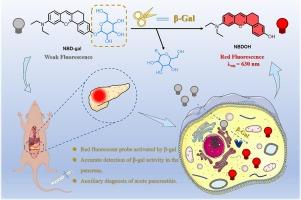β-galactosidase-activated red fluorescent probe assists in the diagnosis of pancreatitis
IF 4.3
2区 化学
Q1 SPECTROSCOPY
Spectrochimica Acta Part A: Molecular and Biomolecular Spectroscopy
Pub Date : 2024-10-10
DOI:10.1016/j.saa.2024.125265
引用次数: 0
Abstract
Acute pancreatitis (AP) is an acute inflammatory disease resulting from abnormal digestion of itself and surrounding organs by pancreatic enzymes caused by a variety of pathogenic factors. When the tissue of a biological organism is afflicted with pancreatitis and experiences swelling, bleeding, and necrotic injuries, the abnormal expression of β-galactosidase (β-Gal) activity becomes one of the main indicators for assisting in the diagnosis of pancreatitis. In this study, a highly specific red fluorescent probe designed for the detection of β-Gal activity has been developed. β-galactoside is used as the enzyme activating group, and the long-wavelength luminescent water-soluble organic molecule NBDOH is used as the luminophore to construct the fluorescent probe NBD-gal. NBD-gal is activated by abnormally overexpressed β-Gal, releasing a strong red fluorescent signal. The new fluorescent probe developed in this study is used to assist in the diagnosis of pancreatitis by detecting abnormal expression of β-Gal activity in vivo. In in vivo imaging experiments, NBD-gal can effectively differentiate between normal nude mice and pancreatitis nude mice. In addition, NBD-gal can be effectively localized in real-time to the pancreas and intestines, which are rich in β-Gal in nude mice. Therefore, NBD-gal exerts great potential in the early diagnosis, treatment, and prevention of biomedical clinical pancreatitis.

β-半乳糖苷酶激活的红色荧光探针有助于诊断胰腺炎
急性胰腺炎(AP)是一种急性炎症性疾病,由多种致病因素引起的胰腺酶对自身和周围器官的消化异常所致。当生物体组织患上胰腺炎并出现肿胀、出血和坏死损伤时,β-半乳糖苷酶(β-Gal)活性的异常表达就成为辅助诊断胰腺炎的主要指标之一。本研究开发了一种高特异性红色荧光探针,用于检测 β-Gal 活性。该探针以β-半乳糖苷为酶活基,以长波长发光的水溶性有机分子NBDOH为发光体,构建了荧光探针NBD-gal。 NBD-gal被异常过表达的β-gal激活,释放出强烈的红色荧光信号。本研究开发的新型荧光探针可通过检测体内β-Gal活性的异常表达来辅助诊断胰腺炎。在体内成像实验中,NBD-gal 能有效区分正常裸鼠和胰腺炎裸鼠。此外,NBD-gal 还能有效地实时定位到裸鼠体内富含 β-Gal 的胰腺和肠道。因此,NBD-gal 在生物医学临床胰腺炎的早期诊断、治疗和预防方面具有巨大潜力。
本文章由计算机程序翻译,如有差异,请以英文原文为准。
求助全文
约1分钟内获得全文
求助全文
来源期刊
CiteScore
8.40
自引率
11.40%
发文量
1364
审稿时长
40 days
期刊介绍:
Spectrochimica Acta, Part A: Molecular and Biomolecular Spectroscopy (SAA) is an interdisciplinary journal which spans from basic to applied aspects of optical spectroscopy in chemistry, medicine, biology, and materials science.
The journal publishes original scientific papers that feature high-quality spectroscopic data and analysis. From the broad range of optical spectroscopies, the emphasis is on electronic, vibrational or rotational spectra of molecules, rather than on spectroscopy based on magnetic moments.
Criteria for publication in SAA are novelty, uniqueness, and outstanding quality. Routine applications of spectroscopic techniques and computational methods are not appropriate.
Topics of particular interest of Spectrochimica Acta Part A include, but are not limited to:
Spectroscopy and dynamics of bioanalytical, biomedical, environmental, and atmospheric sciences,
Novel experimental techniques or instrumentation for molecular spectroscopy,
Novel theoretical and computational methods,
Novel applications in photochemistry and photobiology,
Novel interpretational approaches as well as advances in data analysis based on electronic or vibrational spectroscopy.

 求助内容:
求助内容: 应助结果提醒方式:
应助结果提醒方式:


